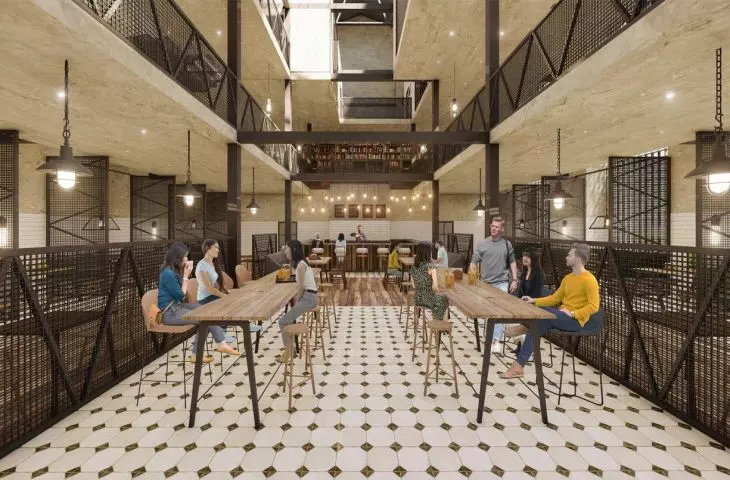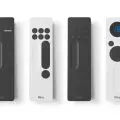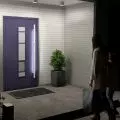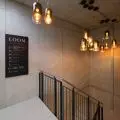Work submitted for the competition
"Best Interior Diploma 2020/2022".
The subject of the diploma thesis is the design of the Ecological Artistic Manufaktura realized on the basis of the building of the former Gwarek bathhouse, formerly belonging to the complex of buildings of the Katowice Coal Mine.
Interior of the bar located on the first floor
© Anna Wyżgoł
The building will combine an entertainment and educational function in the form of art studios along with a library and reading room, complemented by a gastronomic function in the form of a natural juice bar. The idea is the result of inspiration from the area where the building is located, namely the area of the Katowice Cultural Center. The Silesian Museum is undertaking adaptation processes of the post-mining buildings of the former KWK, transforming them into objects popularizing the culture and heritage of the region. Ekologiczna Manufaktura Artystyczna is intended to complement this idea, introducing a less formal way of interacting with art - one in which an ecological approach to products and manufactured objects plays a major role.
The project was implemented on the basis of the former Gwarek bathhouse
© Anna Wyżgoł
The theme of the thesis was mainly dictated by environmental, architectural and site factors. High, arched windows let in a large amount of natural light, and the open concept allows the introduction of additional floors that divide the space architecturally and thematically-functionally. The theme of the building's ecological idea manifests itself in formal solutions, such as the use of recycled materials, as well as in the theme itself. The catering function is performed by a natural juice bar, around which seating is placed - pieces of equipment with a history, older and newer recycled furniture. The library, along with the reading room, will be stocked with books treating various fields of art, culture and history.
The library and reading room are located on level +1
© Anna Wyżgoł
The main idea of the art studios is to have a theme of making products by hand, as well as using seemingly unnecessary and overdue materials at home. All products obtained are to be practical as well as decorative elements in living spaces. The art-textile studio will provide the opportunity to make typical weaving products, while the calligraphy-graphics studio is to juxtapose the two, working in the area of poster and graphic design themes, as well as providing the opportunity to refine interests in artistic writing.
On the top floor, the author has placed art studios
© Anna Wyżgoł
The small-format ceramics and sculpture studio is to be a place where small-size products, such as plates or pots, as well as spatial decorative forms are produced. The aforementioned artistic disciplines and prepared spaces are to promote the concept of "zero waste" and encourage self-development and promote this approach to art.
visualization of the building structure
© Anna Wyżgoł
The formal solutions used in the project stem from the building's history; its industrial character alludes to the period when it served as a warehouse. The preservation and replication of steel column and truss structure elements is a tribute to the architectural legacy of the site. The structures of the balustrades on each floor and the openwork walls on the first floor were directly inspired by the shape of the existing roof girders. The aesthetic specificity of the floor and wall tiles in the catering area is a symbolic reminder of the period when the building served as a bathhouse, upholding its historic character.
The industrial history is alluded to by the use of steel grids
© Anna Wyżgoł
The color scheme and finishing materials, despite the cool, limited color palette, introduce a warm, friendly atmosphere. The different color tones of the wood used differentiate the perception of the space. The use of steel mesh in the balustrades on the floors and staircases, as well as in the construction of the studio's walls and ceilings, also alludes to the industrial history. The color scheme in the project is based on shades of gray and white with accents of green, beige or blue. The most important role is played by wood with different color temperatures.
Anna WYŻGOŁ
Illustrations: © Author


















































